How Natural Gas Burns
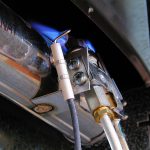 When natural gas burns, energy is released in the form of heat. Three things are required to make this process happen properly in your home appliances: heat from a pilot light, the right amount of fuel, and the right amount of air.
When natural gas burns, energy is released in the form of heat. Three things are required to make this process happen properly in your home appliances: heat from a pilot light, the right amount of fuel, and the right amount of air.
Pilot Light Safety
In some newer appliances, the pilot light is an electrical spark that happens only when you turn on the appliance. Or, the pilot light may be a small flame that burns continuously, using a tiny amount of natural gas as its fuel.
By the way, if you smell a slight odor of natural gas, it may mean that a pilot light has gone out, and you should tell an adult.
What Color Is Your Flame?
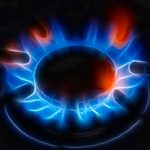 Ranges and other appliances are carefully adjusted to provide the correct gas-to-air mixture. A normal flame (steady, blue, and cone-shaped) means the gas-to-air mixture is perfect.
Ranges and other appliances are carefully adjusted to provide the correct gas-to-air mixture. A normal flame (steady, blue, and cone-shaped) means the gas-to-air mixture is perfect.
While flecks of orange are okay, if the flame is yellow, large, and flickering, the appliance may need a safety adjustment. Ask an adult to have it checked by a qualified repairperson. The exception is decorative gas appliances such as fire logs, which are designed to have a yellow flame.
Carbon Monoxide Alert
You’ve probably heard of carbon dioxide (CO2)—our lungs produce it when we breathe, and trees and plants use it to make oxygen. Carbon monoxide (CO) sounds the same, but it is very different.
Where Does CO Come From?
CO is a dangerous gas that you can’t smell or see. It is produced when people use natural gas or other fuels (such as gasoline, propane, fuel oil, and wood) without enough oxygen. Common sources of CO include gasoline engines running in closed garages, fuel-burning space heaters or water heaters with improper venting, and blocked chimneys or vent pipes.
What Are the Symptoms of CO Poisoning?
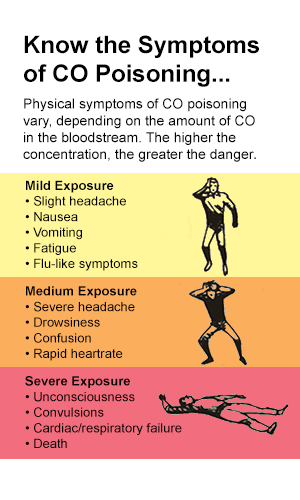 If you breathe in CO, it enters your bloodstream and robs oxygen from blood cells. This is called CO poisoning. The early effects of CO poisoning make you feel like you have the flu, but without the fever. Severe cases of CO poisoning can be deadly.
If you breathe in CO, it enters your bloodstream and robs oxygen from blood cells. This is called CO poisoning. The early effects of CO poisoning make you feel like you have the flu, but without the fever. Severe cases of CO poisoning can be deadly.
If you or someone in your home has these symptoms, get out of the house right away. Call 911, your local fire department, or local emergency medical service from a nearby phone.
How Can You Prevent CO Poisoning?
Tell the adults in your household they can prevent CO poisoning by paying attention to these four safety tips:
- Routinely maintain and inspect all heating systems and any fuel-burning appliances annually.
- Periodically check vents, flue pipes, and chimneys for corrosion or blockages.
- Never run your vehicle or fuel-burning equipment in an enclosed space.
- Buy, install, and use a CO alarm according to the manufacturer’s instructions. (CO alarms are similar to smoke detectors.)
Kitchen Safety
Use a heater to warm the house, not the oven. Natural gas ovens are designed to cook food, not to heat rooms. Using your oven to heat the kitchen could damage the oven.
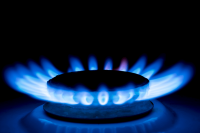 Look for the blue flame. If the burners on top of the range have a blue flame, they are working correctly. While flecks of orange are okay, if your flame is large, yellow, and flickering, ask an adult to have it checked by a qualified repairperson.
Look for the blue flame. If the burners on top of the range have a blue flame, they are working correctly. While flecks of orange are okay, if your flame is large, yellow, and flickering, ask an adult to have it checked by a qualified repairperson.
Don’t play with gas appliances or pipes. Make sure younger sisters or brothers don’t play with oven knobs—they could turn the natural gas on without anyone knowing it. Also make sure they don’t play with the natural gas pipes or flexible connectors that run between the gas range and the wall.
Make the flame fit the pot. Remind the cooks in your family to set the flame just high enough to cover the bottom of the pot. Flames that are too high can make a fire hazard and waste energy. It’s also a good idea to turn pot handles inward toward the back of the range to prevent them from getting bumped.
Heater Safety
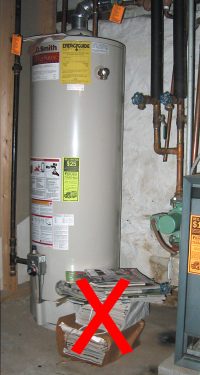 Keep papers and toys away from the furnace and water heater. Don’t store gasoline, paint thinner, or aerosol cans near them either, as the vapors could be ignited by pilot lights or appliance flames.
Keep papers and toys away from the furnace and water heater. Don’t store gasoline, paint thinner, or aerosol cans near them either, as the vapors could be ignited by pilot lights or appliance flames.
Remind adults to have regular inspections. Remind the adults in your home to have your furnace, vents, and chimney inspected every year or two by a qualified service person. Blockages or cracks can make it hard for heating equipment to work properly or can lead to dangerous carbon monoxide buildup.
Use space heaters safely. If you use a vented gas space heater, make sure that it is properly vented to the outside. If you use a vent-free heater, make sure it has a switch that shuts off the heater if indoor oxygen levels get too low. Keep space heaters away from any flammable objects like papers, draperies, etc.
If You Smell Gas
Everyone in Your Family Should Know What to Do
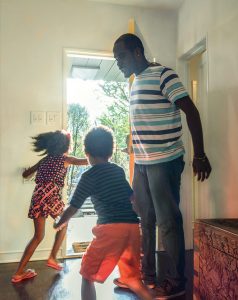 Don’t use fire or electricity. Do not use, turn on, or turn off anything that might create a spark, such as matches, lighters, light switches, phones (including cell phones), flashlights, or any electrical equipment, even computers. Even the tiniest spark from these devices could ignite the natural gas.
Don’t use fire or electricity. Do not use, turn on, or turn off anything that might create a spark, such as matches, lighters, light switches, phones (including cell phones), flashlights, or any electrical equipment, even computers. Even the tiniest spark from these devices could ignite the natural gas.
Get out. Leave your home immediately and take others with you.
Call your gas utility. Go to a safe location and ask a trusted adult to report the leak to 911 and your local natural gas utility.


